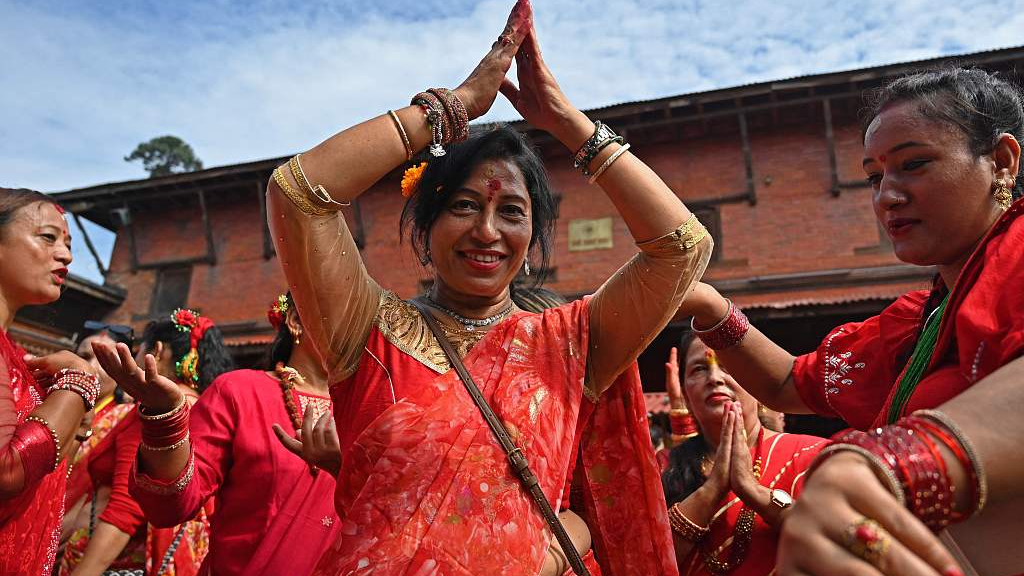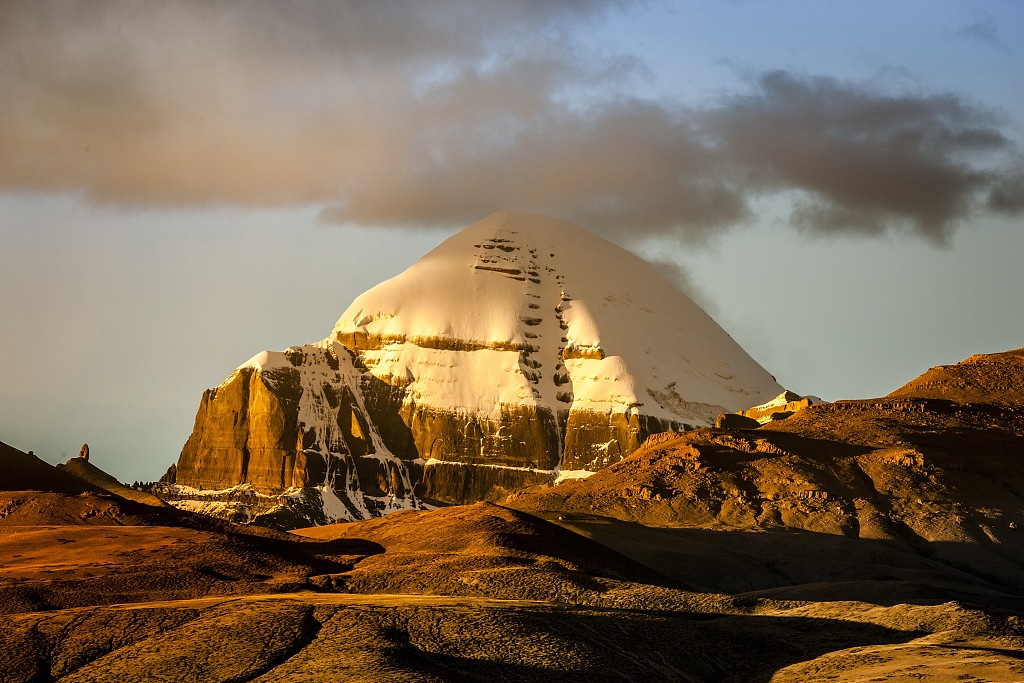
Women dance after offering prayers to Hindu god Shiva during the celebrations to mark the Haritalika Teej festival at Pashupatinath Temple in Kathmandu, capital of Nepal, September 18, 2023. /CFP
Women dance after offering prayers to Hindu god Shiva during the celebrations to mark the Haritalika Teej festival at Pashupatinath Temple in Kathmandu, capital of Nepal, September 18, 2023. /CFP
Editor's note: Birat Anupam, a special commentator on current affairs for CGTN, is a journalist based in Kathmandu, Nepal, who writes mainly on tourism, diplomacy and the environment. The article reflects the authors' opinions and not necessarily the views of CGTN.
Nepalese Prime Minister Pushpa Kamal Dahal Prachanda is visiting China for eight days from September 23. "This is your first visit to China after your third term as Prime Minister of Nepal," said Chinese President Xi Jinping during his meeting with Prachanda. "I am confident that it will yield fruitful results and provide new impetus to the friendly and cooperative relations between the two countries."
Cultural camaraderie has been the DNA of Sino-Nepal ties from people to state level. For example, the formal signing of diplomatic ties between Nepal and People's Republic of China in August 1955 has high hopes for deep cultural connections. "The two governments believe that the establishment of diplomatic relations will also promote further development in the cultural and economic cooperation between the two countries," said the joint communique issued in 1955.
Back in October 2019, Chinese President Xi Jinping also paid a state visit to Nepal. A day before setting foot on the South Asian country, President Xi wrote an important article for Nepali newspaper. In his widely read article, Xi had talked about Sino-Nepal ties from the historic and cultural point of view.
Xi wrote, "More than 1600 years ago, the Chinese and Nepali monks Fa Hien and Buddhabhadra visited each other's country and together translated Buddhist scriptures into Chinese. Their translation works have remained to this day." Xi elaborated more cultural exchanges among the two nations centuries ago and added, "In China's Tang Dynasty (618-907), Nepali Princess Bhrikuti was married to Tibetan King Songtsen Gampo, while the Chinese monk Huen Tsang visited Lumbini, the birthplace of the Buddha, and left many precious written accounts of his pilgrimage."
In the rich cultural exchange between two countries, Buddhism and Hinduism, which are Nepal's two largest religions, have become mainstream. For the Hindus, Shiva is the supreme God. China's Xizang Autonomous Region hosts the holiest Shiva shrine called Mount Kailash, which is the cultural and religious magnet for millions of Hindus from both Nepal and its southern neighbor India. The ever increasing crowds of Nepalis and Indians as well as Hindus from around the world frequenting Mt. Kailash are the crystal clear indicators of China's position as a beacon of Hindu or Vedic civilization.

Mount Kailash is bathed in the afterglow of the sunset in Ngari Prefecture, northwest China's Xizang Autonomous Region, September 22, 2013. /CFP
Mount Kailash is bathed in the afterglow of the sunset in Ngari Prefecture, northwest China's Xizang Autonomous Region, September 22, 2013. /CFP
Last May, leaders of the ruling Communist Party of Nepal (Maoist Center) picked this sacred venue as one of their major stops in China. This shows that Sino-Nepal ties are not limited within the sole cultural domain of Buddhism. It has its cultural roots even in Hinduism. It is this backdrop that makes the China-proposed Global Civilization Initiative (GCI) a great cultural and diplomatic endeavor.
Proposed on May 15 this year, the GCI can be an enabler for cultural connectivity between Nepal and China and beyond. Nepal's position of Buddha's birthplace and China's huge Buddhism heritage and populace are the perfect working domain for Buddhism in the GCI. For Hinduism, Xizang's Mt. Kailash and Nepal's UNESCO-listed Pashupatinath Temple deserve closer connectivity both in cultural and physical domains.
This would be one of the win-win cooperations among Nepal and China under the GCI framework at a time when Nepal's Prime Minister Pushpa Kamal Dahal is making an official visit to China for eight days from September 23. Back in 2017, Nepal signed a memorandum of understanding with China to cooperate on the Belt and Road Initiative (BRI), but Nepal has yet to open up about other China-proposed initiatives than the GCI. On the Global Security Initiative, Nepal's stated foreign policy forbids to be a part of such security-related endeavor.
However, for other initiatives, Nepal and China could open up with frank exchange and in-depth understanding based on mutual respect and trust. The GCI, for the time being, could be a good platform to start with. It has historic, cultural, religious and sentimental attachment among people of both countries, and it could be the institutionalization of the oft-talked about Sino-Nepal cultural camaraderie for centuries.
(If you want to contribute and have specific expertise, please contact us at opinions@cgtn.com. Follow @thouse_opinions on Twitter to discover the latest commentaries in the CGTN Opinion Section.)